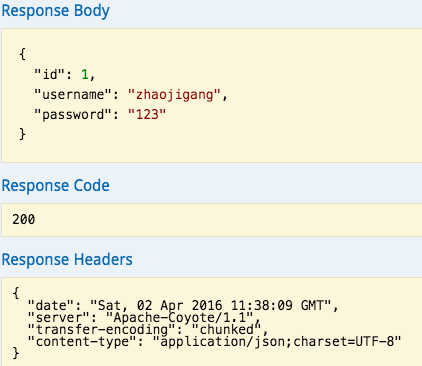第四章 springboot + swagger(转载)
2024-08-25 08:17:41
此篇博客转发自:http://www.cnblogs.com/java-zhao/p/5348113.html
swagger用于定义API文档。
好处:
- 前后端分离开发
- API文档非常明确
- 测试的时候不需要再使用URL输入浏览器的方式来访问Controller
- 传统的输入URL的测试方式对于post请求的传参比较麻烦(当然,可以使用postman这样的浏览器插件)
- spring-boot与swagger的集成简单的一逼
1、项目结构
和上一节一样,没有改变。
2、pom.xml
引入了两个jar。
<dependency>
<groupId>io.springfox</groupId>
<artifactId>springfox-swagger2</artifactId>
<version>2.2.2</version>
</dependency>
<dependency>
<groupId>io.springfox</groupId>
<artifactId>springfox-swagger-ui</artifactId>
<version>2.2.2</version>
</dependency>
3、Application.java
package com.xxx.firstboot; import org.springframework.boot.SpringApplication;
import org.springframework.boot.autoconfigure.SpringBootApplication; import springfox.documentation.swagger2.annotations.EnableSwagger2; @SpringBootApplication //same as @Configuration+@EnableAutoConfiguration+@ComponentScan
@EnableSwagger2 //启动swagger注解
public class Application { public static void main(String[] args) {
SpringApplication.run(Application.class, args);
} }
说明:
- 引入了一个注解@EnableSwagger2来启动swagger注解。(启动该注解使得用在controller中的swagger注解生效,覆盖的范围由@ComponentScan的配置来指定,这里默认指定为根路径"com.xxx.firstboot"下的所有controller)
4、UserController.java
package com.xxx.firstboot.web; import org.springframework.beans.factory.annotation.Autowired;
import org.springframework.web.bind.annotation.RequestHeader;
import org.springframework.web.bind.annotation.RequestMapping;
import org.springframework.web.bind.annotation.RequestMethod;
import org.springframework.web.bind.annotation.RequestParam;
import org.springframework.web.bind.annotation.RestController; import com.xxx.firstboot.domain.User;
import com.xxx.firstboot.service.UserService; import io.swagger.annotations.Api;
import io.swagger.annotations.ApiImplicitParam;
import io.swagger.annotations.ApiImplicitParams;
import io.swagger.annotations.ApiOperation;
import io.swagger.annotations.ApiResponse;
import io.swagger.annotations.ApiResponses; @RestController
@RequestMapping("/user")
@Api("userController相关api")
public class UserController { @Autowired
private UserService userService; // @Autowired
// private MyRedisTemplate myRedisTemplate; @ApiOperation("获取用户信息")
@ApiImplicitParams({
@ApiImplicitParam(paramType="header",name="username",dataType="String",required=true,value="用户的姓名",defaultValue="zhaojigang"),
@ApiImplicitParam(paramType="query",name="password",dataType="String",required=true,value="用户的密码",defaultValue="wangna")
})
@ApiResponses({
@ApiResponse(code=400,message="请求参数没填好"),
@ApiResponse(code=404,message="请求路径没有或页面跳转路径不对")
})
@RequestMapping(value="/getUser",method=RequestMethod.GET)
public User getUser(@RequestHeader("username") String username, @RequestParam("password") String password) {
return userService.getUser(username,password);
} // @RequestMapping("/testJedisCluster")
// public User testJedisCluster(@RequestParam("username") String username){
// String value = myRedisTemplate.get(MyConstants.USER_FORWARD_CACHE_PREFIX, username);
// if(StringUtils.isBlank(value)){
// myRedisTemplate.set(MyConstants.USER_FORWARD_CACHE_PREFIX, username, JSON.toJSONString(getUser()));
// return null;
// }
// return JSON.parseObject(value, User.class);
// } }
说明:
- @Api:用在类上,说明该类的作用
- @ApiOperation:用在方法上,说明方法的作用
- @ApiImplicitParams:用在方法上包含一组参数说明
- @ApiImplicitParam:用在@ApiImplicitParams注解中,指定一个请求参数的各个方面
- paramType:参数放在哪个地方
- header-->请求参数的获取:@RequestHeader
- query-->请求参数的获取:@RequestParam
- path(用于restful接口)-->请求参数的获取:@PathVariable
- body(不常用)
- form(不常用)
- name:参数名
- dataType:参数类型
- required:参数是否必须传
- value:参数的意思
- defaultValue:参数的默认值
- paramType:参数放在哪个地方
- @ApiResponses:用于表示一组响应
- @ApiResponse:用在@ApiResponses中,一般用于表达一个错误的响应信息
- code:数字,例如400
- message:信息,例如"请求参数没填好"
- response:抛出异常的类
- @ApiModel:描述一个Model的信息(这种一般用在post创建的时候,使用@RequestBody这样的场景,请求参数无法使用@ApiImplicitParam注解进行描述的时候)
- @ApiModelProperty:描述一个model的属性
以上这些就是最常用的几个注解了。
需要注意的是:
- ApiImplicitParam这个注解不只是注解,还会影响运行期的程序,例子如下:

如果ApiImplicitParam中的phone的paramType是query的话,是无法注入到rest路径中的,而且如果是path的话,是不需要配置ApiImplicitParam的,即使配置了,其中的value="手机号"也不会在swagger-ui展示出来。
具体其他的注解,查看:
https://github.com/swagger-api/swagger-core/wiki/Annotations#apimodel
测试:
启动服务,浏览器输入"http://localhost:8080/swagger-ui.html"

最上边一个红框:@Api
GET红框:method=RequestMethod.GET
右边红框:@ApiOperation
parameter红框:@ApiImplicitParams系列注解
response messages红框:@ApiResponses系列注解
输入参数后,点击"try it out!",查看响应内容:

最新文章
- PHP 知识点
- [Android]Volley源码分析(五)
- jQuery easyui combobox获取值|easyui-combobox获取多个值
- 基本概率分布Basic Concept of Probability Distributions 3: Geometric Distribution
- mvc 方法只允许ajax访问
- Cloudera CDH 、Impala本地通过Parcel安装配置详解
- php发送get、post请求的几种方法
- CentOS安装,更新Python
- Linux Shell编程(28)——进程替换
- oracle 查询前一小时、一天、一个月、一年的数据
- Java之可变参数
- 阅读&lt;反欺骗的艺术&gt;思考
- 在SpringBoot使用Druid进行数据监控
- C/C++面试题:编写类String的构造函数、析构函数和赋值函数。
- kubernetes集群搭建(1):环境准备
- vue-cli脚手架搭建项目简单入门一
- Xcode中的Vim--XVim
- live555学习(一)通读Makefile编译live555
- linux rpm 安装后 mysql 默认安装目录等信息
- 【转载】K-NN算法 学习总结